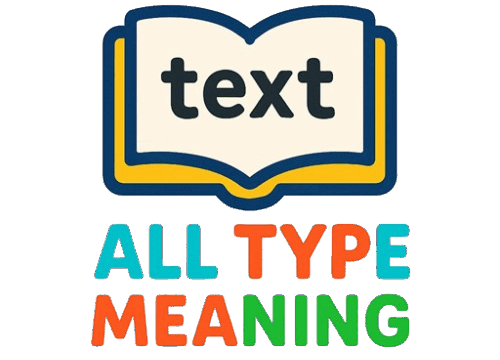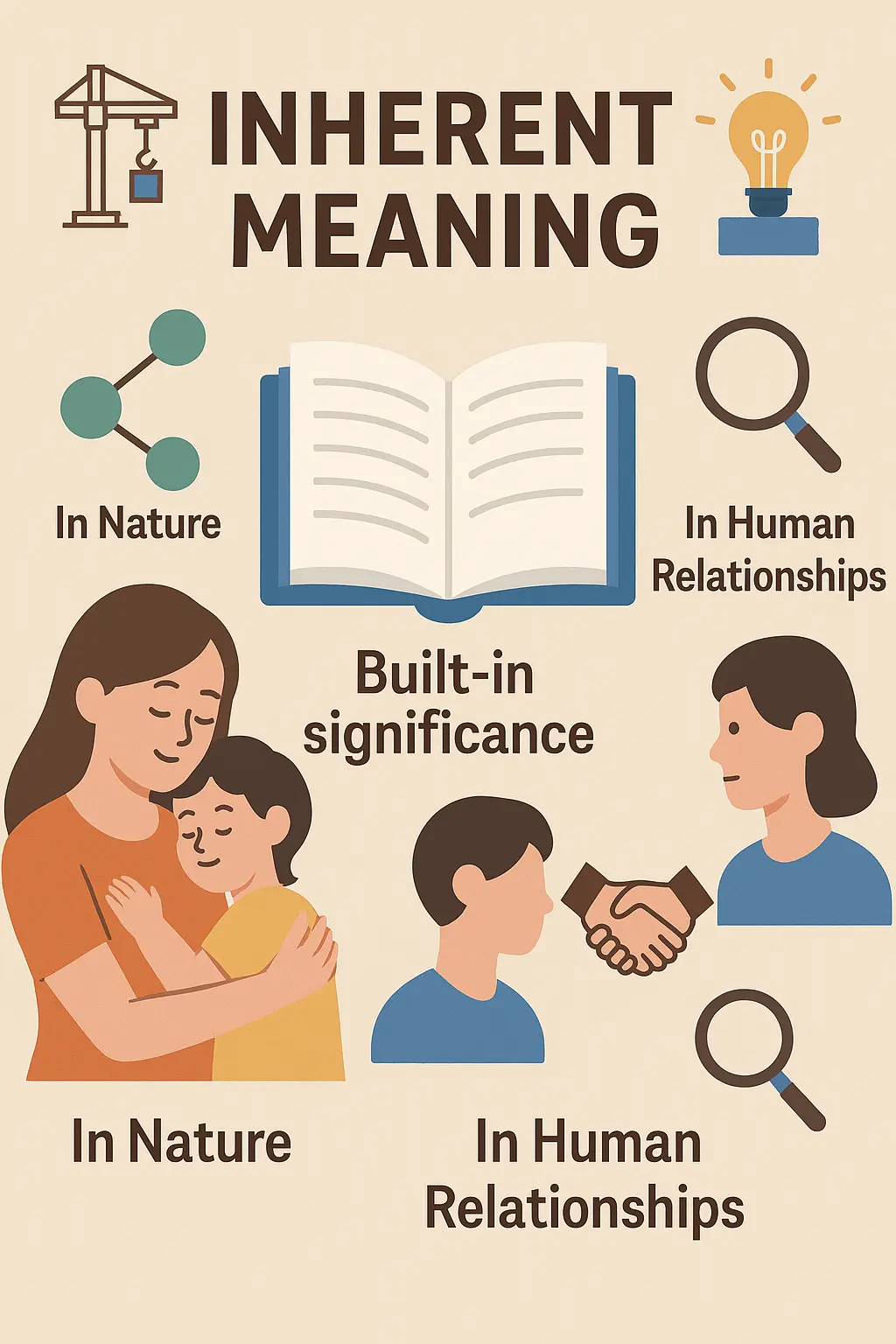Have you ever wondered what makes something naturally belong to a particular thing or situation? The concept of “inherent meaning” is fundamental to understanding how certain qualities, characteristics, or significance exist naturally within something without being added from outside. Let’s explore this fascinating concept in simple terms that everyone can understand! 🌟
What Does Inherent Mean? The Foundation 🏗️
Before diving into “inherent meaning,” let’s understand what “inherent” means. The word “inherent” comes from Latin, meaning “to stick to” or “to cling to.” When something is inherent, it exists as a natural or basic part of something else. It’s not added later – it’s already there from the beginning!
Think of it like this: sweetness is inherent in sugar, wetness is inherent in water, and brightness is inherent in the sun. These qualities naturally belong to these things and cannot be separated from them.
Inherent meaning refers to the natural, built-in significance or importance that something possesses by its very nature. It’s the meaning that doesn’t need to be explained or added because it’s already there, woven into the fabric of the thing itself.
Inherent Meaning in Different Languages 🌍
Understanding concepts in multiple languages helps us grasp their full significance. Here’s how “inherent meaning” translates across various Indian languages:
Inherent meaning in Hindi: अंतर्निहित अर्थ (Antarnihit Arth) – meaning the significance that lies within naturally
Inherent meaning in Tamil: உள்ளார்ந்த பொருள் (Ullarntha Porul) – referring to the inner essence or natural significance
Inherent meaning in Telugu: అంతర్గత అర్థం (Antargata Artham) – describing the internal or natural meaning
Inherent meaning in Bengali: অন্তর্নিহিত অর্থ (Antornihito Ortho) – indicating the embedded or natural significance
Inherent meaning in Marathi: अंतर्भूत अर्थ (Antarbhut Arth) – expressing the naturally contained meaning
Inherent meaning in Kannada: ಅಂತರ್ಗತ ಅರ್ಥ (Antargata Artha) – signifying the intrinsic or natural meaning
Inherent meaning in Malayalam: അന്തർലീനമായ അർത്ഥം (Antharleenamaya Artham) – representing the inherent or natural significance
Inherent meaning in Punjabi: ਅੰਤਰਨਿਹਿਤ ਅਰਥ (Antarnihit Arth) – denoting the naturally embedded meaning
Inherent meaning in Gujarati: આંતરિક અર્થ (Antarik Arth) – describing the internal or natural meaning
Real-Life Examples of Inherent Meaning 🎯
Understanding inherent meaning becomes easier when we see it in action. Here are some practical examples that students and learners can relate to:
In Nature 🌱
- A mother’s love for her child has inherent meaning – it’s naturally protective, nurturing, and unconditional
- The sun rising each day carries inherent meaning of hope, new beginnings, and life-giving energy
- Water flowing downhill has the inherent meaning of following natural laws and finding the easiest path
In Human Relationships 👥
- A handshake has inherent meaning of greeting, agreement, or respect in many cultures
- A smile carries inherent meaning of friendliness, happiness, or welcome
- Tears have inherent meaning of emotion, whether joy, sadness, or overwhelm
In Education and Learning 📚
- Reading a book has inherent meaning of gaining knowledge, entertainment, or expanding understanding
- Asking questions carries inherent meaning of curiosity, desire to learn, and intellectual growth
- Taking notes has inherent meaning of preserving important information for future reference
In Art and Creativity 🎨
- Colors have inherent meanings – red often means passion or danger, blue suggests calm or sadness
- Music carries inherent emotional meaning that transcends language barriers
- Stories have inherent meaning in teaching lessons, sharing experiences, or entertaining
How to Identify Inherent Meaning in Daily Life 🔍
Recognizing inherent meaning helps us better understand the world around us. Here are simple steps to identify it:
Step 1: Look for Natural Qualities
Ask yourself: “What qualities does this thing naturally possess?” For example, fire naturally has the qualities of heat, light, and energy. These aren’t added to fire – they’re part of what makes fire, fire.
Step 2: Consider Universal Understanding
Inherent meanings are often understood across cultures and languages. A baby’s cry naturally means they need something, regardless of where in the world you are.
Step 3: Think About Automatic Associations
What do you automatically think of when you see or experience something? The inherent meaning of rain might be life, growth, cleansing, or renewal – these associations come naturally.
Step 4: Observe Consistent Patterns
Inherent meanings remain consistent over time and across different situations. The inherent meaning of darkness (mystery, rest, fear, or the unknown) has been consistent throughout human history.
The Importance of Understanding Inherent Meaning 💡
Why should students and learners care about inherent meaning? Here are several compelling reasons:
Better Communication Skills 🗣️
When you understand the inherent meaning of words, gestures, and symbols, you communicate more effectively. You choose words that carry the right natural significance for your message.
Enhanced Critical Thinking 🧠
Recognizing inherent meaning helps you analyze information more deeply. You can distinguish between what something naturally means and what meaning others might try to impose on it.
Cultural Awareness 🌏
Different cultures may assign different inherent meanings to the same things. Understanding this helps you navigate diverse environments with sensitivity and respect.
Academic Success 📖
In literature, science, and other subjects, recognizing inherent meaning helps you grasp concepts more quickly and remember them better.
Personal Growth 🌱
Understanding the inherent meaning of your actions, relationships, and choices helps you make decisions that align with your natural values and goals.
Common Mistakes When Understanding Inherent Meaning ⚠️
Students often make these mistakes when trying to understand inherent meaning:
Mistake 1: Confusing Added Meaning with Inherent Meaning
Sometimes we assign meaning to things based on our experiences rather than recognizing their natural significance. For example, you might dislike cats because one scratched you, but the inherent meaning of cats includes companionship, independence, and comfort.
Mistake 2: Thinking All Meanings Are Inherent
Not all meanings are inherent. Some are learned, cultural, or personal. The inherent meaning of a red rose is beauty and life, but the added cultural meaning of “love” varies by society.
Mistake 3: Ignoring Context
While inherent meaning is natural, context can influence how we perceive it. Rain has inherent meaning of life and growth, but during a flood, we might focus more on its destructive potential.
Mistake 4: Assuming Universal Agreement
While inherent meanings are natural, people might interpret them differently based on their experiences and cultural backgrounds.
Practical Exercises to Master Inherent Meaning 📝
Here are some simple exercises students can practice:
Exercise 1: Daily Observation
Each day, identify three things around you and write down their inherent meanings. For example:
- Your textbook: Learning, knowledge, growth
- A tree outside: Life, stability, growth, oxygen
- Your favorite pen: Communication, expression, creativity
Exercise 2: Cross-Cultural Comparison
Choose a symbol or object and research its inherent meaning across different cultures. How is it similar or different?
Exercise 3: Personal Reflection
Think about important relationships in your life. What inherent meanings do they carry? How do these natural significances influence your interactions?
Exercise 4: Literature Analysis
When reading stories or poems, identify what has inherent meaning versus what meaning the author has added for artistic effect.
Conclusion:
Understanding Inherent meaning enriches our daily experiences and deepens our connection to the world around us. It helps us recognize the natural significance that exists in everything from simple objects to complex relationships. Whether you’re a student preparing for exams, a curious learner exploring new concepts, or someone who simply wants to understand life better, grasping inherent meaning is a valuable skill.
Remember, inherent meaning exists naturally – it doesn’t need to be forced or created. It’s already there, waiting to be recognized and appreciated. By developing your ability to identify and understand inherent meaning, you’ll become a more thoughtful communicator, a deeper thinker, and a more aware participant in the beautiful, meaningful world around us.
The next time you encounter something new, pause and ask yourself: “What meaning does this naturally carry?” You might be surprised by the depth and richness of significance that surrounds us every day! ✨
Frequently Asked Questions (FAQ) ❓
Q1: What is the difference between inherent meaning and symbolic meaning?
A: Inherent meaning exists naturally within something by its very nature, while symbolic meaning is assigned by humans or cultures. For example, water has the inherent meaning of life and nourishment, but a wedding ring has symbolic meaning of marriage that humans have assigned to it.
Q2: Can inherent meaning change over time?
A: True inherent meaning doesn’t change because it’s based on natural qualities. However, our understanding or perception of inherent meaning can deepen or become clearer as we gain more knowledge and experience.
Q3: How do I know if a meaning is inherent or just cultural?
A: Ask yourself: “Would this meaning exist even if no human culture had ever developed?” If yes, it’s likely inherent. For example, the sun’s inherent meaning of providing light and warmth would exist regardless of human culture.
Q4: Is inherent meaning the same in all languages?
A: Yes, the core inherent meaning remains the same across languages because it’s based on natural qualities. However, different languages might emphasize different aspects of that inherent meaning or express it in culturally specific ways.
Q5: Can objects made by humans have inherent meaning?
A: Yes, but it’s more complex. A knife, for example, has the inherent meaning of cutting or separating because that’s what its design naturally allows it to do, regardless of cultural interpretations.
Want to learn more unique word meanings? Don’t miss our detailed guide on Annihilate Meaning and how to use it in real life! 🌱

